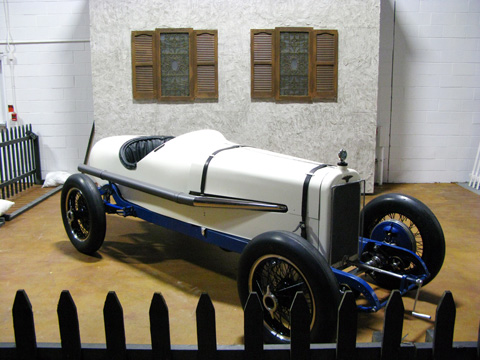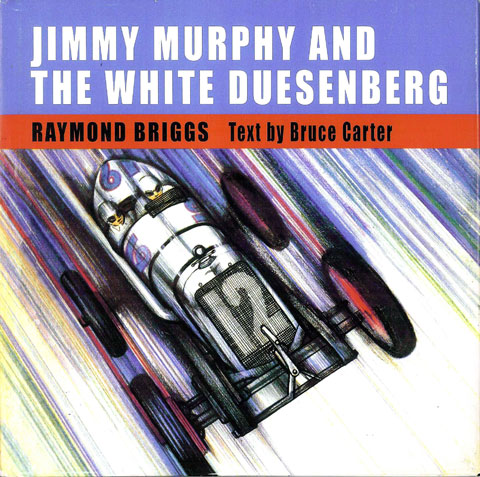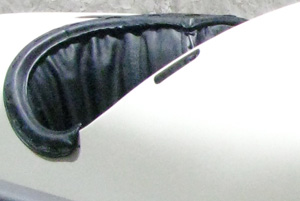
Posed in front of a LeMans setting, the ex-Joe Boyer Duesenberg now rests at the Simeone Foundation in Philadelphia, PA.
Duesenberg’s win at the 1921 French Grand Prix at Le Mans was
significant for what it was as well as marking the gap that would follow. It was a landmark victory by an American car with an American team of drivers that would not be repeated until the Gurney/Foyt Ford GT 40 Mk IV in 1967, forty-six years later.
The exciting story of the Duesenberg’s victory in France is described in the children’s book, “Jimmy Murphy and the White Duesenberg”, now republished by Joe Freeman. (read review)

Cover of “Jimmy Murphy and the White Duesenberg”.
Unlike the Nuvolari P3 on which the second children’s book is based, (read review of “Nuvolari and the Alfa Romeo“) the famous Duesenberg that Murphy piloted to victory is not as easy to find. But there are three sources of information about the car, its driver and the times.
The first is author Gary Doyle, who has written the definitive book on Jimmy Murphy, “King of the Boards, The Life and Times of Jimmy Murphy.” The second, open and available to children of all ages, is the Indianapolis Motor Speedway Museum. At the Simeone Foundation in Philadelphia, one of the Le Mans team cars is displayed against a backdrop of the Le Mans event in which it competed.
Probably no longer exists
For many years it was assumed that the Duesenberg at the Indianapolis Museum was the real thing-it was an early find, the old timers were still around to give judgment, and it seemed likely that most of the car at least was based on the original winning team car. The story of the find was recounted in a 1987 issue of “Automobile Quarterly” V25 No. 1, by Frederick A. Usher. But after years of more research Doyle is not so sure. “The Speedway ‘found’ a Duesenberg supposedly on the west coast and passes it off as Murphy’s car at the Speedway Museum. It is a car made from parts and though it looks, sounds, acts, like the Murphy car it is not,” he wrote. If that’s not the car, then where is it? “It no longer exists,” says Doyle.
There were three team cars entered for the French Grand Prix of 1921. No one is quite sure what happened to all of the cars-and in fact there were four 183 cubic inch eight cylinder Duesenbergs shipped to France that year, but only three actually entered. And only one has come down to us with a provenance that is both plausible and verifiable.
“The only French Grand Prix Duesenberg still around is the Joe Boyer car that Fred Simeone has in the Simeone Foundation” said Doyle. And sure enough, the story of the Boyer car is as amazing as the race winner’s. What historian Griff Borgeson said about the 1921 race- “It would make a great movie but no one would believe it”-could be applied to the emergence of an old barn find as one of the official team entries to the French Grand Prix. The full story of the Simeone Duesenberg can be found in the book “The Spirit of Competition” (read review) but we’ll recap it below, courtesy of Fred Simeone.
Provenance: Two owners since the late 1920s
In 1921, a Duesenberg race car was sold to Harry Hartz, who raced it and finished second in the 1922 Indianapolis 500. Updating it with a Miller engine and a new nose, Hartz drove his last race with it in April of 1923. The Duesenberg -Miller then went to the east coast, and was seen at Langhorne in 1926. Some time after, it was purchased by the Burgert brothers of Philadelphia. The brothers attempted to qualify for the Indy 500 in 1931 and 1932, but failed and the car returned to the Burgert’s garage. It was found in 1955 by Fred Simeone’s father, who bought it and a number of spares. Fred would inherit a race car that had only two owners since the late 1920s.
Enter Freeman and Roe
As remarkable as the story so far goes, it was only a prelude to an even more important discovery. Fred’s father did not attempt a restoration, but Fred went ahead and restored the car to its last “as raced” condition, which included the Miller engine and modified nose. Then, a few years after the restoration, Joe Freeman (publisher of “Jimmy Murphy and the White Duesenberg”) and historian Fred Roe dropped by one day and inspected the car. It didn’t take long for them to determine that what Simeone had was the 1921 car raced by Joe Boyer in the French Grand Prix.
During the race on the 18th lap, Boyer’s engine threw a rod and the car was retired. Back in the States, the car was repaired and sold to Harry Hartz who installed the Miller engine and modified the nose. The chronology was clear and consistent. “Freeman was particularly anxious to have me put the car back to its1921 Grand Prix glory,” writes Fred. A correct engine (one which had also blown a rod leaving a patched hole in the block) was found and restored, and the body was returned to the Le Mans configuration.
Got a handle on it
In addition to the amazing provenance, the Simeone Duesenburg has a feature which marked the car from its Le Mans appearance. The Boyle car had been described by historians as the “hand hold” car, because it is the only one with a cutout in the cowl for the mechanic to hold on.

Close up of the cowl with the hand hold.
Then, Fred caught an old movie, “Kid Speed”, which featured a racing scene of a Duesenberg, which clearly shows his old car, with the Miller nose, and the handle hold in the cowl. That dated it back to 1924, only three years after the French Grand Prix.
Lacking the original winner, the Simeone Duesenberg nevertheless was a French Grand Prix team car and as close as one will ever get to the real thing. Kids of all ages are invited to see it at the Simeone Foundation.
(Gary Doyle is also the author of Ralph De Palma, Gentleman Driver. For information about Doyle’s motorsports writing, visit his website, www.king-of-the-boards.com)
Fred Simeone has a fabulous collection – and now that I found out about the Duesenberg grand prix car being there, I shall return for another visit!